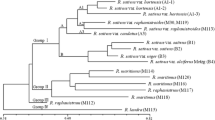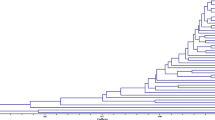Abstract
Two approaches were used to detect variability within 23 pea cultivars. Eight random amplified polymorphic DNA (RAPD) primers produced 163 bands (114 polymorphic), whereas five isoenzyme systems produced 25 bands (20 polymorphic). Both methods provided good results in finger-printing and identified all cultivars tested. Genetic similarity analysis (UPGMA) gave different results from RAPD and isoenzyme data. This could reflect different properties of both marker types. These data were also analysed using the bootstrap method, which supported the idea of one common progenitor of cultivated peas.
Similar content being viewed by others
References
Angevin, F.: Description of Varieties of Pea, Field Bean and Lupin in the European Union.-UNIP, Paris 1995.
Bagheri, A., Paull, J.G., Langridge, P., Rathjen, A.J.: Genetic distance detected with RAPD markers among selected Australian commercial varietics and boron tolerant exotic germplasm of pea (Pisum sativumL.).-Mol. Breed. 1: 193-197, 1995.
Ben-Ze'ev, N., Zohary, D.: Species relationships in the genus Pisum.-Israel J. Bot. 22: 73-91, 1973.
Chase, C.D., Ortega, V.M., Vallejos, C.E.: DNA restriction fragment length polymorphisms correlate with isozyme diversity in Phaseolus vulgarisL.-Theor. appl. Genet. 81: 806-811, 1991.
Cactano-Anollés, G., Callahan, L.M., Williams, P.E., Weaver, K.R., Gresshoff, P.M.: DNA amplification fingerprinting analysis of bermudagrass (Cynodon): genetic relationships between species and interspecific crosses.-Theor. appl. Genet. 91: 228-235, 1995.
Chunwongse, J., Martin, G.B., Tanksley, S.D.: Pre-germination genotypic screening using PCR amplification of half-seed.-Theor. appl. Genet. 86: 694-698, 1993.
Cooke, R.J.: The characteristics of Pisum sativumL. (partim) (field pea) cultivars by sodium dodecylsulphate-polyacrylamide gel eledrophoresis.-J. nat. Inst. agr. Bot. 16: 213-220, 1983.
Cooke, R.J.: The characterisation and identification of crop cultivars by electrophoresis.-Electrophoresis 5: 59-72, 1984.
Dellaporta, S.L., Wood, J., Hicks, J.B.: A plant DNA minipreparation: Version II.-Plant mol. Biol. Rep. 1: 19-21, 1983.
Dirlewanger, E., Isaac, P., Cousin, R., de Vienne, D.: Molecular markers linked to the resistance genes to main pea diseases.-In: Proc. 1stEur. Conf. Grain Legumes. Pp. 129-130. Angers 1992.
Dirlewanger, E., Isaac, P.G., Ranade, S., Belajouza, M., Cousin, R., de Vienne, D.: Restriction fragment length polymorphism analysis of loci associated with disease resistance genes and developmental traits in Pisum sativumL.-Theor. appl. Genet. 88: 17-27, 1994.
Felsenstein, J.: Confidence limits on phylogenies: an approach using the bootstrap.-Evolution 39: 783-791, 1985.
Felsenstein, J.: Phylogenies from molecular sequences, influence and reliability.-Annu. Rev. Genet. 22, 521-565, 1988.
Gantotti, B.V., Kartha, K.K.: Pea.-In: Evans, D.A., Sharp, W.R., Ammirato, P.V. (ed.): Handbook of Plant Cell Culture, Vol. 4: Techniques and Applications. Pp. 370-418. Macmillan, New York 1986.
Gepts, P.: The use of molecular and biochemical markers in crop evolution studies.-Evol. Biol. 27: 51-94, 1993.
Hoey, B.K., Crowe, K.R., Jones, V.M., Polans, N.O.: A phylogenetic analysis of Pisumbased on morphological characters, and allozyme and RAPD markers.-Theor. appl. Genet. 92: 92-100, 1996.
Hynes, M.J.: Genetically controlled electrophoretic variants of a storage protein in Pisum sativum.-Aust. J. biol. Sci. 21: 827-829, 1968.
Jaccard, P.: Nouvelles recherches sur la distribution florale.-Bull. Soc. Vaud. Sci. Nat. 44: 223-270, 1908.
Klimyuk, V.L., Carrol, B.J., Thomas, C.M., Jones, J.D.G.: Alkali treatment for rapid preparation of plant material for reliable PCR analysis.-Plant J. 3: 493-494, 1993.
Przybylska, J.: Identification and classification of the Pisumgenetic resources with the use of electrophoretic protein analysis.-Seed Sci. Technol. 14: 529-543, 1986.
Samec, P.: DNA polymorphism and RAPD technology.-Genet. Šlecht. (Praha) 29: 291-320, 1993.
Samec, P., Našince, V.: Detection of DNA polymorphism among pea cultivars using RAPD technique.-Biol. Plant. 37: 321-327, 1995.
Samec, P., Našinec, V.: The use of RAPD technique for the identification and classification of Pisum sativumL. genotypes.-Euphytica 89: 229-234, 1996.
Stejskal, J., Pošvec, Z., Griga, M.: Utilisation of isoenzyme and protein spectra for identification of pea (Pisum sativumL.) cultivars.-Biológia (Bratislava) 51: 99, 1996.
Šuška, M.: Isoenzymes from pea (Pisum) leaves and their use in cultivar identification.-Genet. Šlecht. (Praha) 29: 27-33, 1993.
Šuška, M., Stejskal, J.: The electrophoretic identification of pea (Pisum sativumL.) cultivars by seed protein analysis.-Rost. Výroba (Praha) 38: 203-208, 1992.
Swiecicki, W.K., Wolko, B.: Application of electrophoretic methods of isozymes separation to genetical characterisation of pea (Pisum sativumL. s. lat.) cultivars.-Genet. Pol. 28: 89-99, 1987.
Tanksley, S.D.: Molecular markers in plant breeding.-Plant mol. Biol. Rep. 1: 3-8, 1983.
Tanksley, S.D., Young, N.D., Paterson, A.H., Bonierbale, M.W.: RFLP mapping in plant breeding: new tools for an old science.-Bio/Technology 7: 257-264, 1989.
Thomson, J.A., Schroeder, H.E., Dudman, W.F.: Cotyledonary storage proteins in Pisum sativum. I. Molecular heterogeneity.-Aust. J. Plant Physiol. 5: 263-279, 1978.
Timmerman, G.M., Frew, TJ., Weeden, N.F., Miller, A.L., Goulden, D.S.: Linkage analysis of er-l, a recessive Pisum sativumgene for resistance to powdery mildew fungus (Erysiphe pisiD.C.).-Theor. appl. Genet. 88: 1050-1055, 1994.
Vallejos, C.E.: Enzyme activity staining.-In: Tanksley, S.D., Orton, T.J.: (ed.): Isozymes in Plant Genetics and Breeding. Part A. Pp. 469-516. Elsevier, Amsterdam-Oxford-New York 1983.
Weeden, N.F., Ambrose, M., Swiecicki, W.: Pisum sativum, pea.-In: O'Brien, S.J. (ed.): Genetic Maps. Locus Maps of Complex Genomes, Book 6. Pp. 6.24-6.34. Cold Spring Harbor Laboratory Press, New York 1993.
Williams, J.G.K., Kubelik, A.R., Livak, K.J., Rafalski, J.A., Tingey, S.V.: DNA polymorphisms amplified by arbitrary primers are useful as genetic markers.-Nucl. Acids Res. 18: 6531-6535, 1990.
Williams, J.G.K., Hanafey, M.K., Rafalski, J.A., Tingey, S.V.: Genetic analysis using random amplified polymorphic DNA markers. Recombinant DNA, part I.-In: Wu, R. (ed.): Methods in Enzymology. Vol. 218. Pp. 704-740. Academic Press, San Diego 1993.
Rights and permissions
About this article
Cite this article
Samec, P., Pošvec, Z., Stejskal, J. et al. Cultivar Identification and Relationships in Pisum Sativum L. Based on RAPD and Isoenzymes. Biologia Plantarum 41, 39–48 (1998). https://doi.org/10.1023/A:1001700213655
Issue Date:
DOI: https://doi.org/10.1023/A:1001700213655




